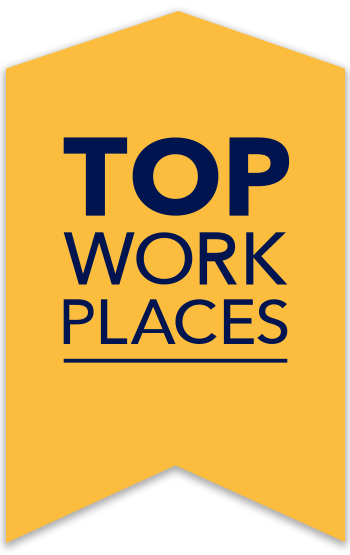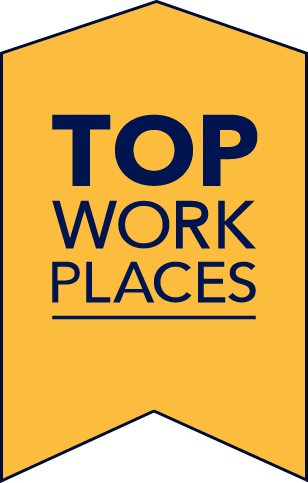At Top Workplaces, we focus on employee engagement because it has real-life benefits for individuals. And it directly impacts company efficiency and profitability. So many factors, like efficiency, motivation from leadership, and the employee experience, influence company culture and economic performance.
Companies and leadership teams must do everything they can to help their employees avoid low productivity. It’s the most rewarding way to improve communication, culture, and efficiency— but it’s also necessary for continued profitability. Both external and internal factors can impact productivity at costly levels. Let’s dive into it.
What is productivity?
So, what is workplace productivity? It measures overall economic performance levels by comparing company output to input. More specifically, how much work it takes to produce a specific amount of goods or services. While employees focus on their daily productivity levels, leadership have a wider view, measuring and adjusting different teams as needed.
With proper communication and education, this balanced effort helps companies achieve more efficient, sustained success. Plus, focusing on productivity is an excellent opportunity to readjust and gather data about employee motivation.
Causes of low productivity levels
The first step in addressing productivity is identifying where it’s coming from. Although causes can be external or internal, most end up being internal, with straightforward solutions. Here are the most common causes of low productivity. Remember: active, honest, and open conversations are essential.
Management and leadership
Research shows that leadership impacts organizational culture a lot. Poor management affects productivity by reducing efficiency. It also impairs employees’ ability to discuss roadblocks openly. Specific issues like inconsistent communication, manager burnout, and micromanagement can decrease employee morale and honesty.
Managers and senior leaders are responsible for employee motivation, especially when productivity goals aren’t met. If they seem hesitant to help employees improve efficiencies, they need to care more about company performance or employee retention. When times are tough, it’s their job to remain optimistic and find solutions.
Training and development
A lack of training and development opportunities is also one of the most common causes of low productivity. Aligning professional development initiatives that benefit company productivity is an effective solution for higher performance and employee engagement. Ask your employees what they want to learn and consider how their ideas could also help business goals.
Learn more: Improve Training and Development
Diversity
Diversity, equity, and inclusion are critical drivers of employee engagement and performance. They are also crucial for creativity, education, and innovative ideas— which all positively impact company productivity. When teams with different backgrounds and experiences work together, they can create more unique solutions and connect with more customers. The fewer biases you have, the better.
Here are some Top Workplaces for DE&I and a blog post highlighting companies with the best diversity and inclusion.
Work environment/ company culture
Bad company cultures and challenging work environments are other common causes of low productivity at work. From physical factors, like natural light and workplace flexibility, to atmosphere issues, like toxicity among employees or lack of appreciation— many components in a work environment can chip away at productivity and performance more than you might think.
Compensation
Employees’ salaries also impact their commitment and motivation to get things done. While research suggests it’s not one of the strongest engagement drivers, compensation does matter to employees. Low compensation makes them feel unappreciated, while high compensation encourages them to keep working hard and growing with the organization.
Employee well-being
Poor mental and physical health impacts productivity a ton. Employees who don’t feel well will work less efficiently and waste more time. They might also take more sick days. Offering paid time off and other employee well-being benefits is a great way to invest in your employees’ mental health and well-being.
When you improve employee well-being, people start to feel refreshed and reconnected. That means they work harder and feel committed to the vision and shared goals. Plus, that wellness, and the productivity that comes with it, can be contagious.
Tools and technology
Employee productivity depends on technology and tools. Advances in technology benefit every industry, making it possible that you could find a more current, efficient way to complete processes and work together. Without the right tools, employees are more likely to feel disengaged, frustrated, and inefficient. Using technology to your advantage is a great way to prevent employee burnout and make it easier to be productive.
Effects of low productivity levels
Employees who aren’t working at their highest potential feel exhausted by their processes and can become burnt out. If companies do not address productivity issues, it’s only a matter of time before they lose their competitive advantages, money, and top talent. Here is a list of the common, costly effects of low productivity.
Reduced profit
Low productivity levels hurt business growth and profit due to a reduced amount of profitable work. When employees can’t deliver quality goods or services at a profitable rate, it’s time to evaluate efficiency roadblocks. If production costs continue to exceed the money coming in, your business could be in big trouble.
Disengaged employees
Employee engagement measures how connected, motivated, and satisfied people feel within their company. Team morale and engagement drop substantially when companies have low productivity. When employees are disengaged, they no longer need to satisfy customers or go the extra mile. Combined with efficient processes, that is not safe for your bottom line.
Read more: Signs of Engaged Employees
Unutilized resources
Low production levels mean a company isn’t maximizing its employees, technology, tools, or time. That inefficiency leads to fewer profits and more frustrations. Employees have every right to be frustrated when their resources fall short or their coworkers waste time on unproductive tasks. It’s up to leaders to monitor and improve resource usage.
Increased employee burnout and turnover
Putting in extra energy takes a toll on employees. Left unchanged, inefficiencies can cause higher employee turnover and give your company a bad reputation. Just think about it, when processes are inefficient, employees overexert themselves and become more exhausted. That exhaustion leads to employee burnout and a toxic culture, two main reasons why employees leave.
Lack of motivation, creativity, and innovation
Employees who are stressed about meeting productivity goals don’t have a lot of time to drive the business forward. Creativity, innovation, and self-motivation are the last thing on individuals’ minds when they’re just trying to get through the day. Productive systems and processes help companies find time for brainstorming and innovation, which are both necessary for growth.
Motivate employees with Top Workplaces employer recognition
Awards and recognition are excellent employee motivation tactics. People want to be part of a winning team and enjoy the celebration that comes with it.
Top Workplaces awards are based entirely on employee feedback. Use the recognition to reinforce your organization’s commitment to people-first culture and informed decision-making.

 Stand out with an award-winning
Stand out with an award-winning
